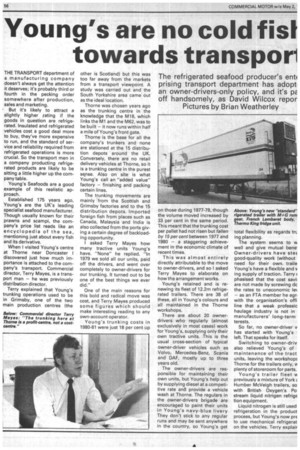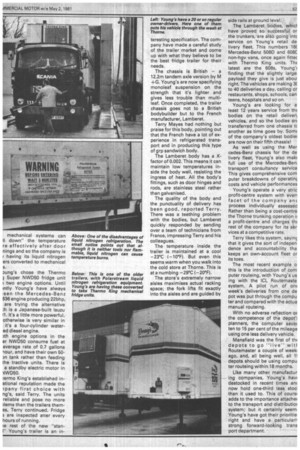Young's are no cold fist towards transpori
Page 66

Page 67

If you've noticed an error in this article please click here to report it so we can fix it.
The refrigerated seafood producer's ent( prising transport department has adopt, an owner-drivers-only policy, and it's pE off handsomely, as David Wilcox repor
Pictures by Brian Weatherley
THE TRANSPORT department of a manufacturing company doesn't always get the attention it deserves; it's probably third or fourth in the pecking order somewhere after production, sales and marketing.
But it's likely to attract a slightly higher rating if the goods in question are refrigerated. Insulated and refrigerated vehicles cost a good deal more to buy, they've more expensive to run, and the standard of service and reliability required from refrigerated operations is more crucial. So the transport men in a company producting refrigerated products are likely to be sitting a little higher up the company table.
Young's Seafoods are a good example of this realistic approach.
Established 175 years ago, Young's are the UK's leading specialist seafood manufacturer. Though usually known for their prawns and scampi, the company's price list reads like an encyclopedia of the sea, mentioning just about every fish and its derivative.
When I visited Young's centre at Thorne near Doncaster I discovered just how much im portance is attached to the company's transport. Commercial director, Terry Mayes, is a trans port man — he was previously distribution director.
Terry explained that Young's trunking operations used to be in Grimsby, one of the two main production centres (the other is Scotland) but this was too far away from the markets from a transport viewpoint. A study was carried out and the South Yorkshire area came out as the ideal location.
Thorne was chosen years ago as the trunking centre in the knowledge that the M18, which links the M1 and the M62, was to be built — it now runs within half a mile of Young's front gate.
Thorne is the base for all the company's trunkers and none are stationed at the 15 distribution depots around the UK. Conversely, there are no retail delivery vehicles at Thorne, so it is a trunking centre in the purest sesise. Also on site is what Young's call an "added value" factory — finishing and packing certain lines.
The trunking movements are mainly from the Scottish and Grimsby factories and to the 15 distribution depots. Imported foreign fish from places such as Canada, Malaysia and India is also collected from the ports giving a certain degree of backloading opportunity.
I asked Terry Mayes how many tractive units Young's have. "None" he replied. "In 1979 we sold all our units, paid off the drivers, and went over completely to owner-drivers for our trunking. It turned out to be one of the best things we ever did."
One of the main reasons for this bold and radical move was cost, and Terry Mayes produced some figures which should make interesting reading to any own-account operator.
Young's trunking costs in 1980-81 were just 18 per cent up on those during 1977-78, though the volume moved increased by 33 per cent in the same period. This meant that the trunking cost per pallet had not risen but fallen by 15 per cent between 1977 and 1980 — a staggering achievement in the economic climate of recent times.
This was almost entirely directly attributable to the move to owner-drivers, and so I asked Terry Mayes to elaborate on how the arrangement works.
Young's retained and is renewing its fleet of 12.2m refrigerated trailers. There are 38 of these, all in Young's colours and all maintained in the Thorne workshops.
There are about 20 ownerdrivers who regularly (almost exclusively in most cases) work for Young's, supplying only their own tractive units. This is the usual cross-section of typical owner-driver vehicles such as Volvo, Mercedes-Benz, Scania and DAF, mostly up to three years old.
The owner-drivers are responsible for maintaining their own units, but Young's help out by supplying diesel at a competitive rate and provide a vehicle wash at Thorne. The regulars in the owner-drivers brigade are encouraged to paint their units in Young's navy-blue livery They don't stick to any regular runs and may be sent anywhere in the country, so Young's get total flexibility as regards trL ing planning.
The system seems to vs,
well and give mutual bene. Owner-drivers have stet good-quality work (without need for their own traile Young's have a flexible and v ing supply of traction. Terry
phasised that the cost savii are not made by screwing dc the rates to uneconomic le% -as an FTA member he agn with the organisation's offi line that a weak professio haulage industry is not in manufacturers' long-term terests.
So far, no owner-driver v has started with Young's left. That speaks for itself.
Switching to owner-driv also relieved Young's of maintenance of the tract units, leaving the workshop: Thorne for the trailers only, vi plenty of storeroom for parts. Young's trailer fleet v■ previously a mixture of York Humber McVeigh trailers, so with British Oxygen's Po stream liquid nitrigen refrige tion equipment.
Liquid nitrogen is still used refrigeration in the product process, but Young's now pr€ to use mechanical refrigerat on the vehicles. Terry explair
mechanical systems can H down" the temperature re effectively after door nings and so the company is r having its liquid nitrogen ers converted to mechanical S.
Dung's chose the Thermo Super NWD50 fridge unit r two engine options. Until intly Young's have always e n the Mercedes-Benz 836 engine producing 22bhp, are trying the alternative is a Japanese-built Isuzu 11. It's a little more powerful, otherwise is very similar in it's a four-cylinder watered diesel engine.
)th engine options in the er NWD50 consume fuel at average rate of 0.7 gallons lour, and have their own 50n tank rather than feeding the tractive units. There is a standby electric motor in NJWD50.
)ermo King's established inational reputation made the Ipany first choice with ng's, said Terry, The units reliable and pose no more )Iems than the trailers themes, Terry continued. Fridge 3 are inspected atter every hours of running.
re rest of the new "stanI" Young's trailer is an in teresting specification. The cornpany have made a careful study of the trailer market and come up with what they believe to be the best fridge trailer for their needs.
The chassis is British — a 12.2m tandem axle version by M +G. Young's are now specifying monoleaf suspension on the strength that it's lighter and gives less trouble than multileaf. Once completed, the trailer chassis goes not to a British bodybuilder but to the French manufacturer, Lamberet.
Terry Mayes had nothing but praise for this body, pointing out that the French have a lot of experience in refrigerated transport and in producing this type of grp sandwich body.
The Lamberet body has a Kfactor of 0.002. This means it can maintain low temperatures inside the body well, resisting the ingress of heat. All the body's fittings, such as door hinges and rods, are stainless steel rather than galvanised.
The quality of the body and the punctuality of delivery has been good, reported Terry. There was a teething problem with the bodies, but Lamberet quickly responded by sending over a team of technicians from France, impressing Terry and his colleagues.
The temperature inside the trailer is maintained at a cool —23°C (-10°F). But even this seems warm when you walk into the cold store at Thorne, This is at a numbing —29°C (-20°F).
The store's extremely narrow aisles maximises actual racking space; the fork lifts fit exactly into the aisles and are guided by side rails at ground level.
The Lamberet bodies, whici have proved so successful or the trunkers, are also going intc service on Young's retail de livery fleet. This numbers 18( Mercedes-Benz 508D and 608E non-hgv vans, once again fitter with Thermo King units. Th( latest are the 608s, Young'( finding that the slightly large: payload they give is just abou; right. The vehicles are making 3( to 40 deliveries a day, calling or restaurants, shops, schools, can teens, hospitals and so on.
Young's are looking for a least 12 years service from thE bodies on the retail deliver) vehicles, and so the bodies arE transferred from one chassis tE another as time goes by. Sam( of the company's oldest bodie( are now on their fifth chassis!
As well as using the Mer cedes-Benz chassis for the de livery fleet, Young's also mak( full use of the Mercedes-Ben; transport consultancy service This gives comprehensive corn puter breakdowns of operatin,c costs and vehicle performances Young's operate a very stric profit-centre system with even facet of the company anc process individually assessed Rather than being a cost-centre the Thorne trunking operation i( a profit-centre and charges thE rest of the company for its ser vices at a competitive rate.
Terry likes this system, sayinc that it gives the sort of indepen dence and accountability tha keeps an own-account fleet or its toes.
The most recent example o this is the introduction of corn outer routeing, with Young's us ing with the ICL Routemaste system. A pilot run of on week's deliveries from one de pot was put through the compu ter and compared with the actua manual routeing.
With no adverse reflection or the competence of the depot'! planners, the computer save( ten to 15 per cent of the mileage using one less delivery vehicle.
Mansfield was the first of thr depots to go "live" witi Routemaster a couple of week! ago, and, all being well, all 1! depots should be using compu ter routeing with in.18 months.
Like many other manufactur ing companies, Young's havE destocked in recent times am now hold one-third less stocl than it used to. This of coursr adds to the importance attache( to the transport and distributior system; but it certainly seem: Young's have got their priaritie: right and have a particularl. strong forward-looking trans port department.
















































































































